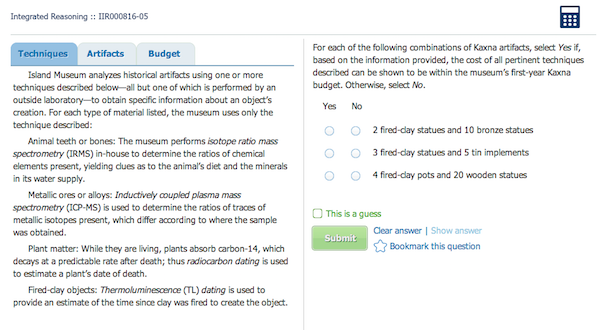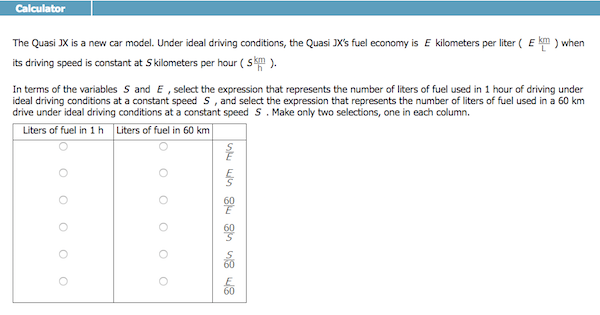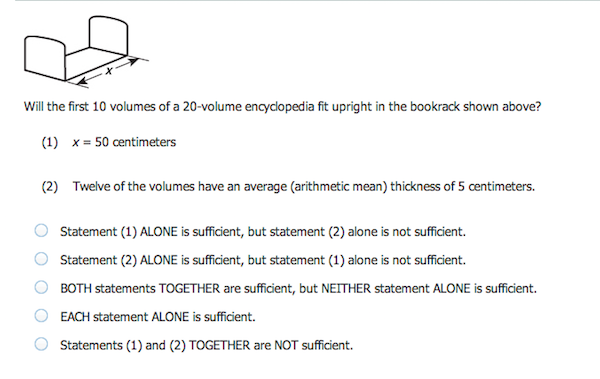
While it’s impossible to know exactly what questions you’ll get on the GMAT, you can predict the structure of the test. Everybody gets a slightly different version, but each test taker sees the same GMAT pattern.
This guide will go over the GMAT exam pattern so you know exactly what to expect. After reading this article, you won’t have any surprises when it comes to format.
To start, let’s go over what you need to know about the GMAT before taking this unique test.
GMAT Logistics: What You Need to Know
The GMAT is always a computer-based test with four sections, Analytical Writing Assessment, Integrated Reasoning, Quantitative, and Verbal, in that order. Each section is strictly timed, and you’re responsible for answering all of the questions in a section before time runs out.
If you don’t get to all of the questions in a section, then your score will take a serious hit. You can only answer one question at a time, and you can’t skip or return to any questions.
Not sure how or what to study? Confused by how to improve your score in the shortest time possible? We've created the only Online GMAT Prep Program that identifies your strengths and weaknesses, customizes a study plan, coaches you through lessons and quizzes, and adapts your study plan as you improve.
We believe PrepScholar GMAT is the best GMAT prep program available, especially if you find it hard to organize your study schedule and don't want to spend a ton of money on the other companies' one-size-fits-all study plans.

The Quantitative and Verbal sections of the GMAT are adaptive, meaning that questions are selected based on your performance as you go along. The adaptive sections rely on an algorithm that matches questions to your ability level.
This adaptive format is meant to gain an accurate measure of your skills. It also allows GMAT scores to be comparable to one another across different versions of the test.
There are experimental questions scattered throughout the Integrated Reasoning, Quantitative and Verbal sections. These experimental questions test out material for future tests, and they don’t count toward your final scores. You won’t have any idea which questions are experimental, though, so you should treat all tasks as equally important.
Now that you have a general sense of how the GMAT works, let’s look more closely at the GMAT exam pattern and format of each section.

What Is the GMAT Exam Pattern? Overall Structure
The GMAT is a three hour exam, plus you can take two optional eight-minute breaks. You’ll also spend between 15 and 20 additional minutes entering score recipients, confirming your personal information, reading instructions, and deciding whether you want to keep or cancel your scores.
The AWA and Integrated Reasoning sections are 30 minutes each, while the Quantitative and Verbal sections are 62 minutes and 65 minutes, respectively.
You can choose one of three orders for the GMAT sections:
- Option 1: Analytical Writing Assessment, Integrated Reasoning, Break, Quantitative, Break, Verbal
- Option 2: Verbal, Break, Quantitative, Break, Integrated Reasoning, Analytical Writing Assessment
- Option 3: Quantitative, Break, Verbal, Break, Integrated Reasoning, Analytical Writing Assessment
This chart shows how many questions you get in each section, along with an estimate of how much time you have per question. Remember that each estimate is just an average. It’s often a better practice to spend more time on certain question types than to divide your time up equally.
| Section | Length of Time | Number of Questions | Time per Question |
| Analytical Writing Assessment | 30 minutes | 1 essay question | 30 minutes |
| Integrated Reasoning | 30 minutes | 12 questions | 2 ½ minutes |
| Quantitative | 62 minutes | 31 questions | 2 minutes |
| Verbal | 65 minutes | 36 questions | About 1 minute and 48 seconds |
| Total time: | 3 hours, 7 minutes (not including breaks) | Average time/question: | 2 minutes (excluding AWA section) |
Again, you’re responsible to getting to all of the questions in each section. Developing an efficient test-taking rhythm is essential for doing well on the GMAT. Now let’s take a closer look at the GMAT test pattern within each section, starting with AWA.

GMAT Pattern: Analytical Writing Assessment Section
The Analytical Writing Assessment is 30 minutes long and asks you to respond to an essay question.
Before you get to your essay, you’ll have 10 minutes to read a tutorial with instructions on the essay and how to navigate the text box. You can find this same tutorial on GMAT practice tests, so you should go into the test already familiar with what it says.
Once you start the section, you’ll see an essay prompt in the form of a short excerpt of an argument. You can actually find the full list of GMAT AWA prompts here. Here’s just one example:
The following appeared in an announcement issued by the publisher of The Mercury, a weekly newspaper:
“Since a competing lower-priced newspaper, The Bugle, was started five years ago, The Mercury’s circulation has declined by 10,000 readers. The best way to get more people to read The Mercury is to reduce its price below that of The Bugle, at least until circulation increases to former levels. The increased circulation of The Mercury will attract more businesses to buy advertising space in the paper.”
After the prompt, the instructions will say the following:
In your essay, your job is to critique the argument, not to talk about your own opinion or views on a subject. You can find sample essays online, as well as look over the rubric that graders use to score your essay. Your AWA score will fall between 1 and 6, and you’ll get it about 20 days after you take the GMAT.

Want to improve your GMAT score by 60 points?
We have the industry's leading GMAT prep program. Built by Harvard, MIT, Stanford, and Wharton alumni and GMAT 99th percentile scorers, the program learns your strengths and weaknesses and customizes a curriculum so you get the most effective prep possible.

How to Prepare for the AWA Format
In the AWA section, you need to write a well-structured and well-organized essay in 30 minutes. To prepare, you should read plenty of highly scored sample essays, as well as the rubric that graders will use to score your essay.
You should also set aside time to write your own practice essays. You might use the first three to five minutes to plan your response, the next 20 to draft, and save three to five minutes at the end to edit and revise.
By dividing your time among planning, drafting, and revising, you can take a structured approach to the AWA section and ensure that you produce a solid response before time is called.
GMAT Pattern: Integrated Reasoning Section
After you write your essay, you’ll move onto a screen with instructions for the Integrated Reasoning (IR) section. Again, you should already be familiar with these instructions. You’ll only get one minute to read them on test day, or you can click through before the minute is up to start working.
The IR section was introduced to the GMAT in 2012. You’ll answer 12 questions in 30 minutes. Unlike the Quantitative and Verbal sections, IR is not adaptive. The questions don’t change based on your performance. This section is scored between 1 and 12.
IR is the only section on the GMAT where you can use a calculator. You can’t bring your own, but rather will use the on-screen calculator tool. You’ll also use drop-down menus to manipulate data. For instance, you might reorganize a chart by its different columns.
So, what’s tested in the IR section? This relatively new GMAT section asks you to evaluate data in multiple formats. This data may be presented in a passage, chart, graph, or other graphic. Your job is to interpret and synthesize information and evaluate statements.
While IR questions are multi-part, you can’t get partial credit. You must answer all parts of an IR question correctly to get points.
There are four question types in the IR section. Read on for a description and sample of each question type.

Integrated Reasoning: 4 Question Types
The four question types in the IR section are table analysis, graphics interpretation, multi-source reasoning, and two-part analysis. Let’s take a closer look at each type, starting with table analysis questions.
Table Analysis Questions
These questions will present you with a table of data. You’ll sort the data to help you evaluate the accuracy of four to five statements. Each statement will have opposing answers, like yes/no, true/false, inferable/not inferable, and you’ll have to select one answer.
Here’s a screenshot of a table analysis question. If you download the GMAT Prep Software, you can practice answering sample questions that are sortable, just like you’ll get on the real exam.
Want to Identify YOUR GMAT Strengths and Weaknesses?
Our proprietary GMAT Diagnostic Assessment creates a customized study plan for you that takes you from registration all the way to test day! It is included with every account and proven to significantly maximize your score.
Get your personalized assessment as part of your 5 day risk-free trial now:


Graphics Interpretation Questions
These questions ask you to interpret a graph or image and then use drop-down menus to complete various response statements. Your job is to choose the answer that makes the answer statements accurate.
Check out this official sample question to get a clearer sense of what graphics interpretation questions are all about.

Multi-Source Reasoning Questions
With these questions, you’ll get a set of tabs that you can click through. Each tab will have information on a certain topic. This information might be presented in the form of a passage, graphic, or chart. You’ll have to use all data from all three tabs to determine the accuracy of various statements.
Here’s a screenshot of a multi-source reasoning question from the GMAT Prep Software.

Two-Part Analysis Questions
Finally, two-part analysis questions present you with a table of answer choices. You have to select one answer from each column to solve a problem. Check out this sample question to see how two-part analysis questions work.


Tips to Prepare for Integrated Reasoning Format
There are a couple of features unique to the Integrated Reasoning section. One is the various drop-down menus that let you reorganize data. You’ll need to practice with GMAT Prep Software to become adept at sorting data in a useful way.
The second feature you should practice using is the on-screen calculator. You won’t be able to bring your own calculator, so you should make sure you can use the computer-based one. There aren’t any special tricks to it, but you may want to practice so you don’t lose time here.
Finally, you’ll need to develop your skills of reading graphs, charts, and other graphics. You’ll find information presented in a huge variety of formats, so you’ll want to be comfortable interpreting and evaluating data in different forms and switching quickly from one to the next.
GMAT Pattern: Quantitative Section
The Quantitative section is one of two adaptive sections on the GMAT. Questions are selected depending on your performance. Basically, adaptive testing works like this — if you get a question right, then your next question will be more difficult. If you get a question wrong, then you will move on to an easier question. It’s not always as straightforward as this, but you get the idea.
The Quantitative section asks you 31 math questions in 62 minutes and is scored between 0 and 60. Even if you haven’t taken math for years, you should be able to do well in this section, because the tested concepts aren’t particularly advanced.
You don’t need to know advanced calculus or statistical analysis. The Quantitative section mainly focuses on arithmetic, algebra, geometry, and logic.
There are two main question types, problem solving and data sufficiency, and they are interspersed throughout. Read on for a description and sample question of each type.

Problem Solving Questions
Problem solving questions are straightforward math problems. You’ll solve these questions and come up with one answer. All of them are multiple choice and feature five answer choices.
Here are a few sample problem solving questions that you could see in this section.
#1:
#2: 
#3: 
Data Sufficiency Questions
Data sufficiency questions are a bit more unusual. They present you with a formula or graphic, followed by a problem and two statements. It’s your job to figure out whether the statements, alone or together, give you enough information to solve the original problem.
You don’t actually have to solve the problem. You just have to indicate whether one of the statements, both, or neither gives you “sufficient data.”
Check out the example problem below. All data sufficiency questions will feature these same five answer choices.


Quantitative Section Format: How to Prepare
The Quantitative section is adaptive, but you shouldn’t worry about that. Some people get in their heads and think that easy-seeming questions mean they’re doing poorly.
However, there’s really no way of understanding the progression of questions as you go, and trying to do so will only sap your precious mental energy. Focus on solving the problems, and you’ll get your scores soon enough.
There isn’t anything particularly unusual about the problem-solving question types in the GMAT Quantitative section. They probably resemble problems on most other math tests you’ve taken. Your main mode of getting ready for these should be reviewing relevant concepts.
The data sufficiency questions are a little more unusual, and you should go into the test familiar with your answer choices. They will always look the same on every data sufficiency question, but they can be confusing if you’re reading them for the first time on test day.
Finally, you should make the most of the note boards and markers you’ll get at the testing center. These are entirely for your own use, and you should fill them up during the Quantitative section as you work out the problems. The note boards won’t be graded, and you’ll return them at the end of the test.

GMAT Pattern: Verbal Section
The Verbal section is 65 minutes long, asks 36 questions, and is adaptive. Like the Quantitative section, it’s scored between 0 and 60. As its name implies, this section tests your verbal skills, including your reading comprehension, understanding of grammar, and critical reasoning.
As in the other three sections of the GMAT, your critical reasoning skills come into play here. You’ll have to evaluate arguments and pinpoint their strengths and weaknesses.
There are three main question types in the Verbal section: reading comprehension, critical reasoning, and sentence correction. Read on to learn more about each type, as well as to see a sample question.
Reading Comprehension Questions
You should get about four passages in the Verbal section. You’ll read through the passages and then answer three or four questions about each one. These questions might ask about meaning, logic, or central premise. You might interpret the passage’s main idea, supporting details, structure, or tone.
Here’s an example of a reading comprehension passage and question on the GMAT.
Schools expect textbooks to be a valuable source of information for students. My research suggests, however, that textbooks that address the place of Native Americans within the history of the United States distort history to suit a particular cultural value system. In some textbooks, for example, settlers are pictured as more humane, complex, skillful, and wise than Native Americans. In essence, textbooks stereotype and depreciate the numerous Native American cultures while reinforcing the attitude that the European conquest of the New World denotes the superiority of European cultures. Although textbooks evaluate Native American architecture, political systems, and homemaking, I contend that they do it from an ethnocentric, European perspective without recognizing that other perspectives are possible.
One argument against my contention asserts that, by nature, textbooks are culturally biased and that I am simply underestimating children’s ability to see through these biases. Some researchers even claim that by the time students are in high school, they know they cannot take textbooks literally. Yet substantial evidence exists to the contrary. Two researchers, for example, have conducted studies that suggest that children’s attitudes about particular cultures are strongly influenced by the textbooks used in schools. Given this, an ongoing, careful review of how school textbooks depict Native Americans is certainly warranted.
Which of the following would most logically be the topic of the paragraph immediately following the passage?
- (A) specific ways to evaluate the biases of United States history textbooks
- (B) the centrality of the teacher’s role in United States history courses
- (C) nontraditional methods of teaching United States history
- (D) the contributions of European immigrants to the development of the United States
- (E) ways in which parents influence children’s political attitudes

Critical Reasoning Questions
About one-third of the questions on the Verbal section will be critical reasoning questions. These questions are reminiscent of your AWA essay, since they present a short argument and ask you to evaluate it.
Rather than writing an entire 30-minute essay about each prompt, though, you’ll answer a multiple choice question. These questions often present statements and ask you which one would weaken, strengthen, or complete the argument. They might also ask you to evaluate structure, find an assumption, make an inference, or evaluate a conclusion.
To see what critical reasoning questions look like, check out this sample question.
According to the Tristate Transportation Authority, making certain improvements to the main commuter rail line would increase ridership dramatically. The authority plans to finance these improvements over the course of five years by raising automobile tolls on the two highway bridges along the route the rail line serves. Although the proposed improvements are indeed needed, the authority’s plan for securing the necessary funds should be rejected because it would unfairly force drivers to absorb the entire cost of something from which they receive no benefit.Which of the following, if true, would cast the most doubt on the effectiveness of the authority’s plan to finance the proposed improvements by increasing bridge tolls?
- Before the authority increases tolls on any of the area bridges, it is required by law to hold public hearings at which objections to the proposed increase can be raised.
- Whenever bridge tolls are increased, the authority must pay a private contractor to adjust the automated toll-collecting machines.
- Between the time a proposed toll increase is announced and the time the increase is actually put into effect, many commuters buy more tokens than usual to postpone the effects of the increase.
- When tolls were last increased on the two bridges in question, almost 20 percent of the regular commuter traffic switched to a slightly longer alternative route that has since been improved.
- The chairman of the authority is a member of the Tristate Automobile Club that has registered strong opposition to the proposed toll increase.

Sentence Correction Questions
Here’s where your understanding of English grammar comes into play. Sentence correction questions present a sentence, often long and wordy, with a certain word or phrase underlined. Your job is to figure out whether the underlined portion has an error, and if it does, how it should read instead.
You’ll get five answer choices with suggested revisions. The first answer choice will always be the same as the underlined portion. You’ll choose this first version if there’s no error in the original sentence.
The instructions will remind you that your answer “should be clear and exact, without awkwardness, ambiguity, redundancy, or grammatical error.” Here’s an example of a sentence correction question on the GMAT.

How to Prepare for the Verbal Section Format
With 36 questions and several long passages, the Verbal section demands that you work fast. You should develop your speed reading skills as you get ready for the GMAT.
You might focus on big picture issues, like organization, tone, and main point, rather than spending too much time reading each and every word. Time-saving strategies like this one will help you do well in this section.
As you can see, there’s a lot that you can learn about the GMAT exam pattern before actually taking the test. While you won’t know exactly what questions you’ll get, you can know how many questions you’ll get, what they’ll look like, and how much time you have per section.
As you get ready for the GMAT, what can you do to specifically prepare yourself for the format of the test?

Getting Ready for the GMAT Exam Pattern: 6 Essential Study Tips
To do well on the GMAT, you definitely need to immerse yourself in reviewing content and developing your skills in math, reading, grammar, critical reasoning, and data interpretation. These study tips, however, are focused specifically on how to prepare for the GMAT pattern and structure.
What can you do to get ready for the format of this strictly timed test? Check out the six tips below to find out!
#1: Familiarize Yourself With the Format
First and foremost, you should take time to learn all about the GMAT test pattern. If you’ve made it to the end of this guide, then that mission is already accomplished!
While there’s a lot you can’t know about the exam, you should minimize surprises as much as possible. That way, you can focus all of your energy on solving problems, and you won’t have to waste time reading through instructions screens or trying to figure out how those tricky data sufficiency questions work.
Understanding the format will also help you start to develop a sense of timing. You know how many questions and how much time you have per section, so you can start to divide up your time in a way that will maximize your efficiency.
#2: Memorize the Instructions
When you take the real GMAT, you’ll get instruction screens between each section. Apart from the AWA tutorial, you’ll only have a minute to glance over these instructions.
Rather than rushing through these screens on test day, take the time to learn all the instructions before test day. You can see them all on practice tests on the GMAT Prep Software.
When you actually take the GMAT, you can use these screens to take a deep breath and switch focus between subject matter, confident that you already know what you need to do know next.

#3: Develop a Test-Taking Rhythm
Unlike a lot of other tests, the GMAT doesn’t let you skip or return to any questions. Plus, it requires you to get to all of the questions in a section before time runs out.
To deal with this format, you should take timed practice tests to develop a rhythm. You’ll find yourself getting more efficient and improving with practice.
As you work on pacing, you should try your best to focus solely on the question in front of you at any given time. If the previous question stumped you, just try to forget about it. You can’t return to it, so continuing to think about it will only make it harder to do well on the next one.
To excel on the GMAT, you need to develop a mindset that focuses only on the question at hand and forgets about questions that have already gone past.
#4: Strive to Answer All of the Questions
Again, you’re responsible for answering all of the questions in each section and will face a severe score penalty if you don’t. On average, you should only spend about two minutes per question. However, you might find yourself spending longer on some question types than on others.
For instance, you’ll probably devote more time to reading a passage and relatively less time to answering the questions that follow. Similarly, you might spend more time on reading comprehension questions overall than on sentence corrections.
As you practice and take the real test, keep an eye on the timer and make sure that you’re working at a pace that will help you get to all of the questions in time. If, conversely, you find yourself rushing, then you might want to slow down to prevent careless errors. You can’t return to any questions, so there’s no point finishing a section with 10 minutes left to spare.

#5: Forget About the Adaptive GMAT Pattern
As you learned above, the Quantitative and Verbal sections are adaptive. An algorithm selects questions for you that match your ability.
If you get one or more questions wrong, then the subsequent questions should become easier. If you’re acing all the questions, then the difficulty level should increase.
The algorithm that selects these questions is a complex one, and there’s no advantage to trying to gauge your performance as you go along. For one, it’s difficult to evaluate the difficulty level of a question accurately. A question may feel easy just because you recently studied the concept, not because it’s actually easier than others.
Second, there are several experimental questions thrown into the mix. These won’t be scored, but you have no way of telling which ones they are.
Some people take the GMAT and freak out when they feel like the questions are getting easier. They assume this means they’re doing badly. There’s really no way of knowing how you’re doing until the end, so trying to crack the code would just distract you.
Use your mental energy on solving problems, and wait until the end to see your scores.
#6: Make the Most of Your Breaks
Finally, you should take advantage of your optional breaks to get up, move around, and stretch. You can also drink water and eat snacks. The GMAT is a long and demanding test, and these breaks will help you get reenergized between sections.
Plus, if you don’t take them, people could be moving in and out of the test room while you’re trying to concentrate. All of this movement could get distracting and make you lose precious time.
If you follow all of these tips, then you’ll be familiar with the GMAT exam pattern and ready to handle the format of this important exam. In closing, let’s go over the key takeaways you should remember about GMAT structure.

GMAT Exam Pattern: Final Thoughts
Whatever version of the GMAT you take, you’ll get a test with the same format as everyone else. You’ll have four sections – Analytical Writing Assessment, Integrated Reasoning, Quantitative, and Verbal – and each will be strictly timed.
You’ll be taking a computer-based test, and the Quantitative and Verbal sections will be adaptive, meaning questions change to match your ability level.
Besides studying content, you should prepare for the GMAT test pattern by developing time management skills and reading all of the instructions before test day.
By familiarizing yourself with the GMAT exam pattern and question types, you can make sure you don’t get any surprises on test day.
What’s Next?
Have you drawn up a study plan for the GMAT yet? Whether or not you’ve started preparing, you should check out this full GMAT syllabus for tips on how to design a personalized study plan that will help you achieve your goals.
Do you know exactly how the GMAT is scored? This guide will tell you everything you need to know about scoring on the GMAT.
Have you chosen a date to take the test? Check out this article on GMAT test dates and how to choose the best one for you.
 PrepScholar GMAT
PrepScholar GMAT